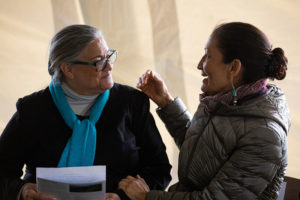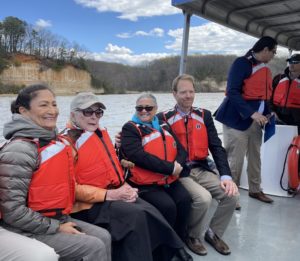Rappahannock Tribe Acquires Sacred Site, Ensuring Perpetual Conservation of Tribe’s Homeland and Bald Eagle Habitat
Partnership with the Chesapeake Conservancy and generosity of a private donor secure protection of sacred site
Richmond County, Virginia. Today, at an event with U.S. Department of the Interior Secretary Deb Haaland, the Rappahannock Tribe announced that it has re-acquired 465 acres at Fones Cliffs, a sacred site to the Tribe located on the eastern side of the Rappahannock River. Prior to contact with the English, the Rappahannock Tribe lived in at least three villages on the Cliffs––Wecuppom, Matchopick and Pissacoack. Fones Cliffs is where the Tribe first encountered and defended their homeland against English settler Captain John Smith during his explorations in 1608.

Rappahannock Tribe Chief Anne Richardson (left) with Department of the Interior Secretary Deb Haaland at the Return to the River Celebration on April 1, 2022. Photo by Will Parson/Chesapeake Bay Program
“We have worked for many years to restore this sacred place to the Tribe. With eagles being prayer messengers, this area where they gather has always been a place of natural, cultural and spiritual importance,” said Rappahannock Tribe Chief Anne Richardson.
“The Department is honored to join the Rappahannock Tribe in co-stewardship of this portion of their ancestral homeland. We look forward to drawing upon Tribal expertise and Indigenous knowledge in helping manage the area’s wildlife and habitat,” said Secretary of the Interior Deb Haaland. “This historic reacquisition underscores how Tribes, private landowners and other stakeholders all play a central role in this Administration’s work to ensure our conservation efforts are locally led and support communities’ health and well-being.”
The Tribe will preserve the land and the wildlife that flourish there including migratory birds and waterfowl. Fones Cliffs is home to bald eagle nests and has been designated by the National Audubon Society as an Important Bird Area with global significance. Eagles are sacred to the Rappahannock Tribe.
The land will be publicly accessible and held with a permanent conservation easement conveyed to the U.S. Fish and Wildlife Service (USFWS). Chesapeake Conservancy donated the easement to the USFWS, then donated the fee title to the Rappahannock Tribe, which intends to place the land in Trust with the Bureau of Indian Affairs. The Tribe plans trails and a replica 16th-century village, where tribal citizens can educate the public about their history and Indigenous approaches to conservation and connect future generations of Rappahannock youth to their tribal traditions and the river which bears their name.
“Relationships, knowledge-sharing and co-stewardship with Indigenous peoples are essential to the Service’s mission,” said U.S. Fish and Wildlife Service Director Martha Williams. “We have the direction and tools to ensure collaboration between the Service and Tribes, and to protect cultural, trust and treaty resources on Service lands, in support of our shared priority of conserving fish, wildlife and their habitats.”

Left to right: U.S. Department of the Interior Secretary Deb Haaland, Dr. Carol Angle, Rappahannock Chief Anne Richardson, Chesapeake Conservancy President & CEO Joel Dunn. Photo by Randall Larrimore/Chesapeake Conservancy
“Through the generosity of the family of William Dodge Angle, M.D., Chesapeake Conservancy is honored to facilitate the return of Fones Cliffs to the Tribe, and to partner with them to bring Indigenous-led conservation practices back to the Rappahannock River,” said Chesapeake Conservancy President and CEO Joel Dunn. “This is a significant step forward in the overall goal to save approximately 2,000 acres at Fones Cliffs, a haven for wildlife and waterfowl and one of the most beautiful places in the Chesapeake and in fact, the world.”
The donation restores an iconic site to the Tribe, who were forcibly removed from the Cliffs after 1649 as English settlers took over valuable farmland.
“Warmest congratulations to the Rappahannock Tribe on the successful conclusion of a long journey to reacquire their ancestral lands at Fones Cliffs,” said U.S. Senator Tim Kaine, who introduced and successfully passed legislation in 2018 to recognize six Virginia Tribes, including the Rappahannock. “I am deeply grateful to all who helped with this effort, including Chief Anne Richardson, the Chesapeake Conservancy and Secretary Haaland and look forward to continuing to work together to ensure that the federal government respects the sovereignty and self-determination of Virginia Tribes. We have a lot of work ahead to undo many wrongs inflicted on Tribal communities, but milestones like this one are a powerful reminder that meaningful steps are possible and necessary.”
“Today marks another important milestone in the history of the Rappahannock Tribe with the acquisition of 465 acres at Fones Cliffs—a sacred site for the Rappahannock people along the Rappahannock River. Throughout my time in the U.S. Senate, I’ve been proud to support the Rappahannock people through federal recognition, housing and COVID relief and now the return of these sacred lands. Today’s actions are a win for all Virginians as we work together to correct historical wrongs and to share in our love for Virginia’s natural beauty. I am inspired by the Rappahannock Tribal leaders who continue their pursuit of justice and thank all partners involved for making this moment possible,” said U.S. Senator Mark R. Warner.
“Today’s announcement continues our nation’s belated recognition and celebration of this land’s earliest inhabitants. The federally recognized tribes of Virginia, including the Rappahannock, share an intertwined history with the English settlers that explored these cliffs at the beginning of the 17th century. Conserving these beautiful cliffs—a favorite site for bald eagles—and sharing the history of the first contact tribes is a gift for all Virginians. I’m so grateful to the many organizations, groups and people that worked diligently on this effort. I also thank the Chesapeake Conservancy, Rappahannock Tribe Chief Anne Richardson and the family of William Dodge Angle, M.D. for embracing this opportunity to ensure the posterity of the Rappahannock,” commented U.S. Representative Rob Wittman.
Additional funding for the Rappahannock Tribe to conserve 465 acres of Indigenous ancestral homelands on the Rappahannock River have also been made possible by a grant from the National Fish and Wildlife Foundation through Walmart’s Acres for America Program.
“We are honored to help return stewardship of the Fones Cliffs site to the Rappahannock Tribe through Walmart’s Acres for America program. In this country and around the world, Indigenous people play an important role in conserving critical ecosystems,” said Chief Sustainability Officer at Walmart and President of the Walmart Foundation Kathleen McLaughlin. “The Acres program supports our ambition to restore, protect or more sustainably manage 50 million acres of land by 2030 as well as our commitment to put nature and people at the heart of our business as we pursue becoming a regenerative company.”
In addition, the land offers opportunities for the Tribe to expand their Return to the River program, which trains tribal youth in traditional river knowledge and practices and conducts outreach and education for other communities interested in the Rappahannock River. In 2017, through the generosity of Ms. Virginia Warner, Chesapeake Conservancy facilitated the donation of a single acre of land near Fones Cliffs, which the Tribe uses as a staging area for the program.
The Rappahannock Tribe is a federally recognized sovereign nation headquartered at Indian Neck in King & Queen County, Virginia. The areas surrounding the Rappahannock River are the ancestral homelands of the Tribe, and the Tribe continues to live, visit and conduct traditional cultural practices along the river. Native fish, bird and plant species along the river are of cultural significance to the Tribe.
The Rappahannock Tribe and Chesapeake Conservancy wish to thank legal counsel for their work on this transaction, including Timothy Choppin at Mayer Brown, Erick J. Giles at Drummond Woodsum, W. Richard Hairfield at Hairfield Morton PLC and Marion F. Werkheiser and her team at Cultural Heritage Partners, PLLC.
###